Estimate Settings
Learn more about the different settings and extra features on your estimates.
On this page:
Status
An estimate can have one of four statuses:
- Open is the default status. It means you're actively working on the estimate form. An estimate in Open status will not appear in the project portal
- Client Review means the estimate has been submitted to your client from commonsku. An estimate will not appear in the project portal until it is in Client Review status or further.
- Converted means the estimate was converted to a sales order, this is an automatic update.
- Closed means the estimate did not result in business/your client has decided not to place an order.
You can manually click the "Status" drop-down to change an estimate's status.
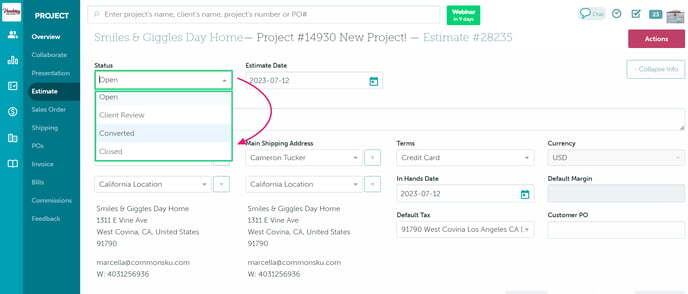
Estimate Date
The estimate date is internal-facing and does not show to your client. It defaults to the estimate's creation date and is useful for future reporting.
Introduction
The introduction appears at the very top of the estimate. It's used to provide the client with additional details or instructions for their estimate form. You can add plain text or dress it up with HTML coding, including iframes.
Client contacts and addresses
The client's billing and shipping contacts and addresses appear at the top of the estimate form.
To change/select the billing or shipping contact, either:
- Click the relevant contact drop-down and choose a contact from the list (as listed on the client page)
- Click the + icon to add a new client contact
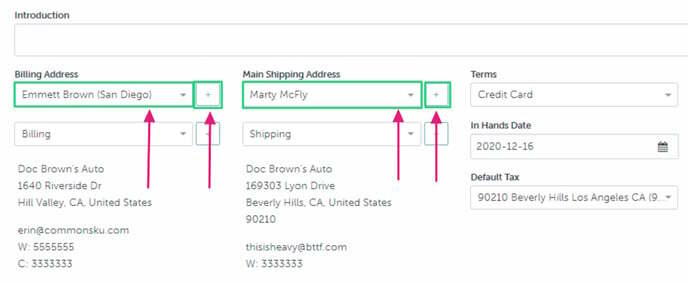
To change/select the billing or shipping address, either:
- Click the relevant address drop-down and choose an address from the list (as listed on the client page)
- Click the + icon to add a new client address
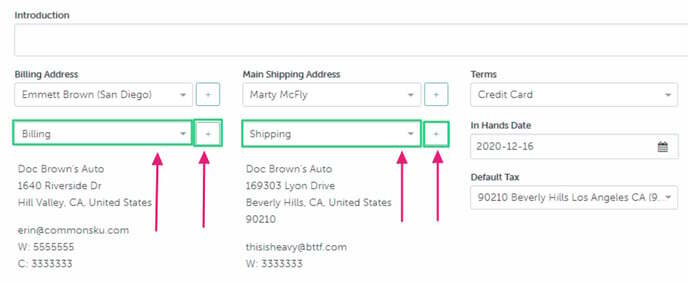
Terms (payment)
The "Terms" field automatically populates with your client's default payment terms, as set on the client page. To change the payment terms on an estimate, click the "Terms" drop-down and select a term from the list.

You can customize your list of payment terms through the Admin tab > Settings.
Currency
This field determines the currency your client will see on their order and defaults to the currency set on the project overview. The best practice is to create separate commonsku clients for each currency your client operates in; that keeps reporting clean inside commonsku and makes it easier to export to your accounting platform.
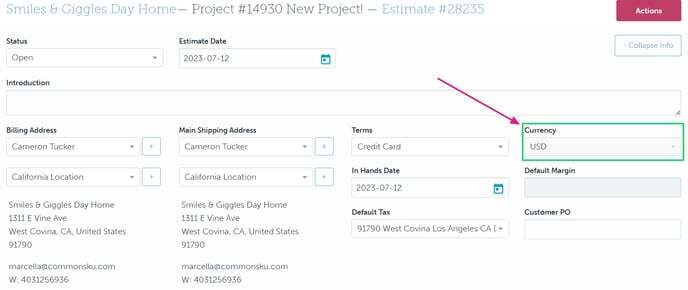
Feel free to contact support@commonsku.com if you have questions about multi-currency.
In Hands Date
The in-hands date is pulled from the project overview's Project Info or the existing presentation's in-hands date. The in-hands date represents when the product needs to be "in the client's hands."
To update the in-hands date, either:
- Click the In Hands Date field on the project overview and select the date you need
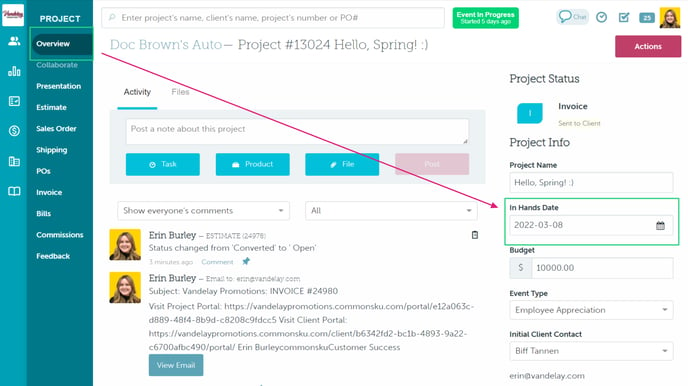
- Click the In Hands Date field on the estimate and select the date you need

Updating the in-hands date on either the project overview only updates the in-hands date on the most recently created form.
Default Tax
The default tax uses the tax set on the client's page.
To change the estimate's default tax, click the "Default" Tax drop-down and select a tax code.
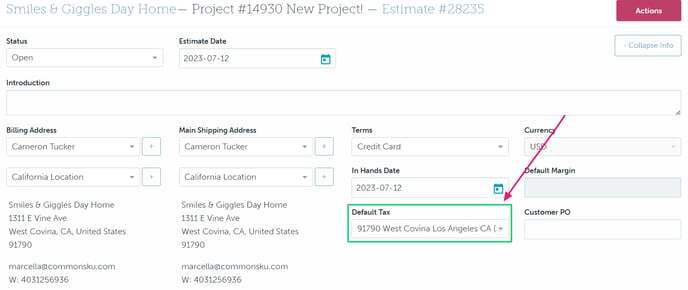
If you're using Zip2Tax and need to override the tax listed:
- Click the "Default Tax" drop-down
- Type the client's zip code into the field and select the tax you need or choose "Exempt"
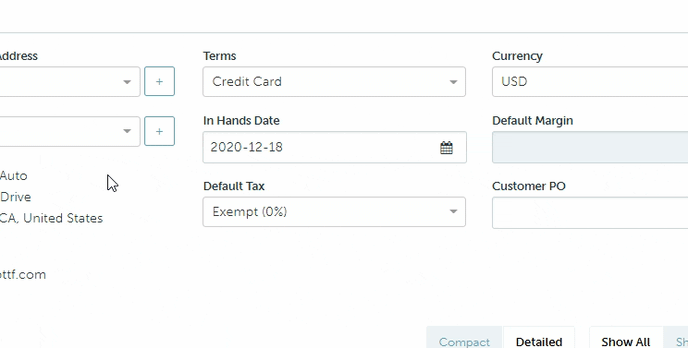
Zip2Tax automatically applies a tax rate based on the estimate's shipping address, as long as the state is listed in your Tax Nexus.
If you're using Avalara and need to override the tax listed:
- Click the "Default Tax" drop-down and choose Avalara
- Select a Default Avalara Category (if needed)
- Select the order's billing and shipping address (a valid shipping address is required to calculate tax)
- After ALL products and services are added and edited as needed, click the Calculate Tax button to calculate a combined tax rate based on the current order details (see best practices)

Customer PO
You can type your customer's purchase order number into this field; it will appear at the top of the estimate.
Products and Artwork
Toggle between the Products and Artwork tabs to view the estimate's items and their artwork details.
Compact vs. Detailed
You can view the internal version of the estimate in either Compact or Detailed view. The internal view does not affect the client-facing estimate form.
Click Compact to view a product's:
- SKU
- Supplier name
- Product name
- Total units
- Margin % per line item
- Client price per line item
The Detailed view is the default setting; it shows a product's:
- SKU
- Supplier name
- Product name
- Product description
- Total units
- Product variants (sizes and colors)
- Margin % per line item
- Client price per line item
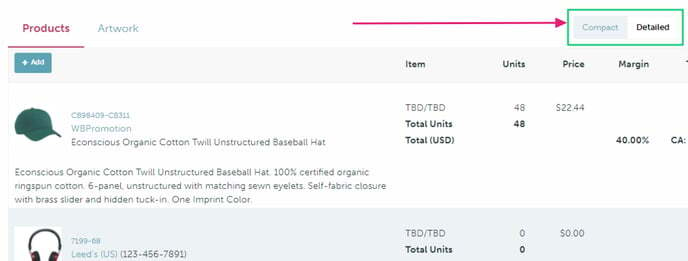
Show All vs. Show Active
Click Show All to view all products, both hidden and shown.
Click Show Active to view products that are showing on the client-facing view.

+Add products
Click the + Add product button to add products to your sales order.

+ Title
Click the + Title button to add Titles or categories to group your products.

+ Services
Click the + Services button to add Services including Custom Service, Freight, Fulfillment, Shipping, Service Po and Other Service

If a custom service has been established in the default settings, it will be displayed as a named service.
Hide, edit, copy, delete
If you hover over a product, you can select to:
- Hide/Show - hides the item from your client's view/shows the hidden item to your client.
- Edit - opens the editing screen for you to change the information displayed to your client.
- Copy - creates a duplicate product.
- Delete - removes the product from the estimate.
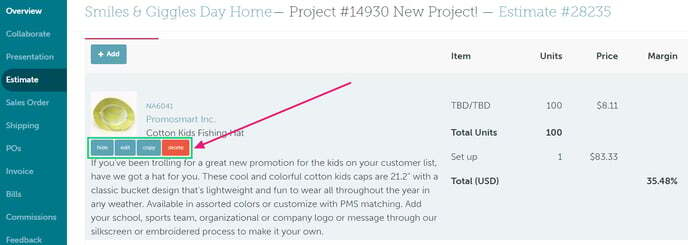
Hide Totals
Rather than showing a total dollar amount for all products on your estimate, you can use the Hide Totals feature to only show totals for the individual products.
To hide your grand totals, check the box next to Hide Totals at the bottom of the form.

Right-click shortcuts
If you hover over a product, you can right-click and select:
- Copy - creates a duplicate product.
- Product - opens your product databases to add a new item under the product you right-clicked on.
- Title - adds a title directly above the product; titles are a simple way to create product categories.
- Freight, Fulfillment, Shipping, Other Service - allows you to add additional services.
FAQ
How can I hide the costs like in a presentation?
How can I hide the costs like in a presentation?
Unlike a presentation, it is impossible to "hide" pricing altogether on an estimate. The only option is to change each product's retail price to $0.